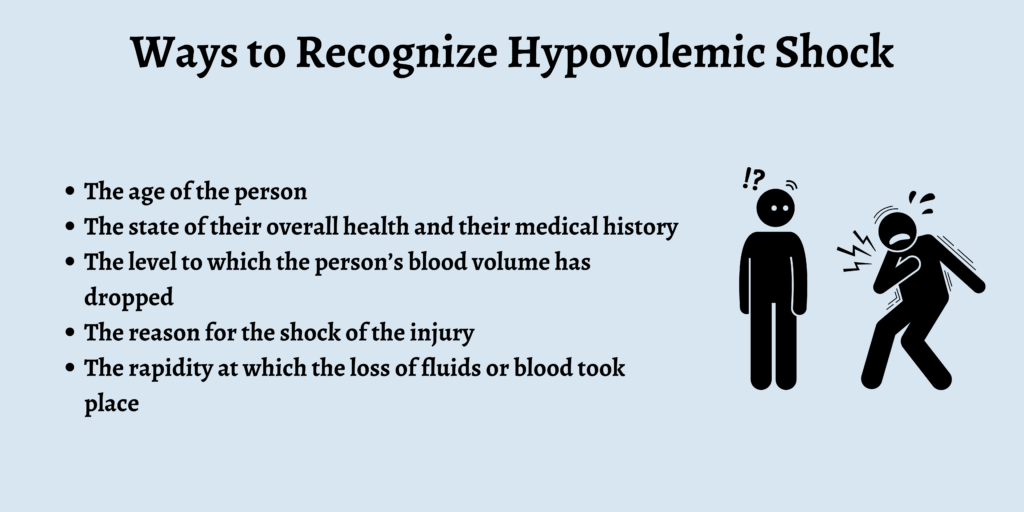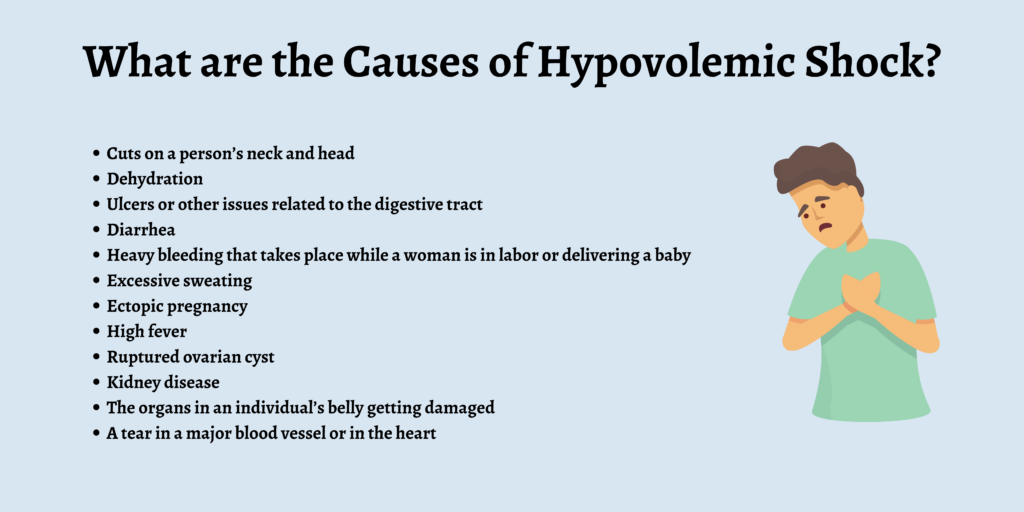How to Recognise Hypovolemic Shock
Hypovolemic shock is a life-threatening condition that occurs when a person’s body loses over 15% of the supply of blood or fluids. As a result, the individual’s heart function gets impaired as it can no longer provide the body with the blood and oxygen required to keep functioning efficiently.
The situation of a hypovolemic shock can also happen when there is major loss of fluids in the form of sweating, vomiting, or diarrhea. During hypovolemic shock, there is initially an increase in the person’s diastolic blood pressure.As the condition progresses and there is further loss of fluids or blood, the patient experiences a decrease in their systolic blood pressure. Hypovolemic shock is known to be the most common type of shock experienced by children and the second most common type of shock overall.
Ways to Recognize Hypovolemic Shock
The ways in which hypovolemic shock presents itself depends on certain factors, such as:
- The age of the person
- The state of their overall health and their medical history
- The level to which the person’s blood volume has dropped
- The reason for the shock of the injury
- The rapidity at which the loss of fluids or blood took place
When there is an injury involved, the easiest way to recognize hypovolemic shock is through the quantity of bleeding. However, the bleeding is difficult to recognize when it takes place internally.
In such cases, there are numerous signs and symptoms that can help someone in recognizing hypovolemic shock, and these symptoms include:
- Weakness
- Feeling tired
- Drop in blood pressure
- Skin being cold and clammy
- Rapid heartbeat
- Breathing that’s shallow and quick
- Feeling confused
- Either peeing little or not at all
- Low temperature· Anxiety
What are the Causes of Hypovolemic Shock?
The causes of hypovolemic shock are many, with some of them being:
- Cuts on a person’s neck and head
- Dehydration
- Ulcers or other issues related to the digestive tract
- Diarrhea
- Heavy bleeding that takes place while a woman is in labor or delivering a baby
- Excessive sweating
- Ectopic pregnancy
- High fever
- Ruptured ovarian cyst
- Kidney disease
- The organs in an individual’s belly getting damaged
- A tear in a major blood vessel or in the heart
How Does Hypovolemic Shock Affect the Body?
The blood in a human being’s body makes up 7% of the body weight, and when an individual experiences hypovolemic shock, the loss of blood or fluids is extremely high. The shock occurs in four stages, and this is what happens at each stage:
Stage 1: The patient loses 15% of their body’s blood. Their heart rate and blood pressure could remain stable during this stage.
Stage 2: The patient loses anywhere between 15% to 30% of the blood from their body. This is when they begin to breathe quicker, and there is an increase in the heart rate.
Stage 3: The breathing keeps getting quicker along with an amplified heart rate. The blood loss is between 30% to 40% at this point, coupled with a severe drop in blood pressure.
Stage 4: More than 40% of the blood is lost from the body by this stage. The heart rate goes really high, and the blood pressure drops.
How is Hypovolemic Shock Diagnosed?
Here is what you should know about the diagnosis related to hypovolemic shock:
- While doing the diagnosis of hypovolemic shock, the doctor will check your breathing, pulse, blood pressure, and temperature.
- The feel and color of your skin will be looked into.
- You will be asked about the condition of your health and any medical problems you may have faced in the past.
- In case the bleeding is related to a person’s reproductive organs, a pregnancy test will be conducted, and you will be questioned regarding your last menstruation and any cases of vaginal bleeding.
The tests that a doctor could recommend for this condition include:
- Blood test
- X-ray
- Echocardiogram
- CT scan
- Urine test· Electrocardiogram
Treatment for Hypovolemic Shock
The treatment for hypovolemic shock involves the following scenarios:
- Once the patient gets in or is taken inside an ambulance, they will be provided with fluids and then blood through an IV.
- The medical team will give the patient the necessary medicines to stabilize their blood pressure levels.
- Oxygen will be delivered to all the body parts.
- The blood loss will either be stopped or brought under control.
- If the bleeding is caused due to an injury, the patient might need surgery.
How Can Hypovolemic Shock Be Prevented?
Since hypovolemic shock is usually caused by traumatic injuries, it can’t be predicted as to when one might experience it. Therefore, preventing it is tricky. However, there are a few things one can remember to reduce the risks in connection to hypovolemic shock:
- If you’re sweating profusely, be sure to keep yourself hydrated and drink lots of water in order to replace the loss of fluids.
- If you’re suffering from diarrhea, consume an electrolyte solution or drink plenty of water to take care of the fluid loss from your body.
- If a person takes diuretics, they should ensure to consume the accurate dose and keep themselves sufficiently hydrated.
How to Look After Someone Post Hypovolemic Shock
After a person gets back home post receiving the required treatment for hypovolemic shock, it’s crucial to follow all the instructions provided by the doctor so as to recover effectively. Make sure that the patient rests well and heals completely before they go back to work.
Consuming the necessary medicines and looking after the healing wounds is essential during the recovery period.
FAQs
1. What causes hypovolemic shock?
Some of the causes of hypovolemic shock include cuts on the neck and head, issues with the digestive tract, and broken bones around a person’s hips.
2. What are the symptoms of hypovolemic shock?
The symptoms of hypovolemic shock are tiredness, weakness, shallow breathing, and low blood pressure.
3. What are the ways to diagnose hypovolemic shock?
Hypovolemic shock can be diagnosed through X-rays, blood tests, and CT scans.
4. Are there any side effects of receiving treatment for hypovolemic shock?
A couple of the side effects of the treatment associated with hypovolemic shock include headache, difficulty in breathing, and increased heart rate.
5. What happens if someone suffers from hypovolemic shock?
If someone suffers from hypovolemic shock, their chances of recovery and survival depend on how much fluid or blood they have lost.
Conclusion
Anyone who goes through a traumatic accident which results in a massive amount of bleeding can experience a hypovolemic shock. The condition also affects anyone whose body loses a tremendous amount of fluids due to throwing up or diarrhea.
Since the condition can prevent the organs in a person’s body from receiving a sufficient quantity of blood and oxygen, it’s imperative to contact emergency medical services right away as soon as the symptoms set in.







